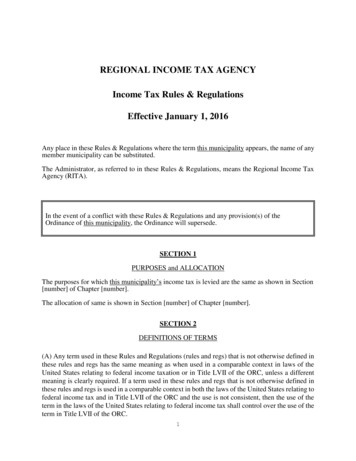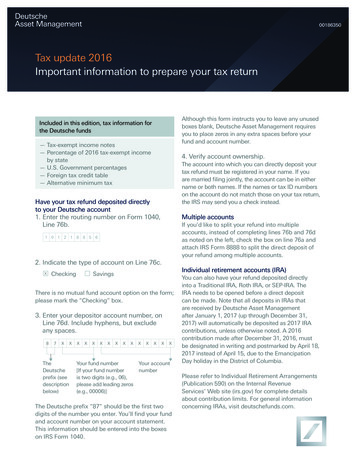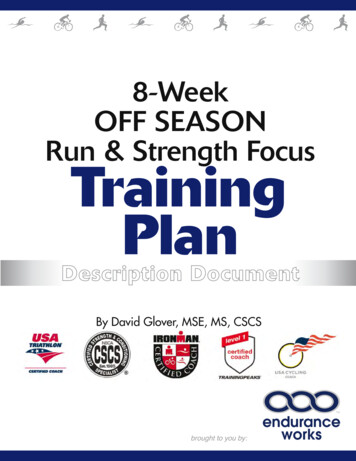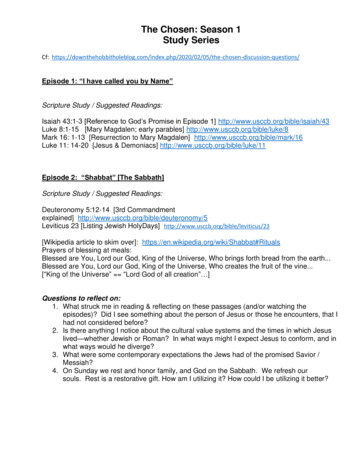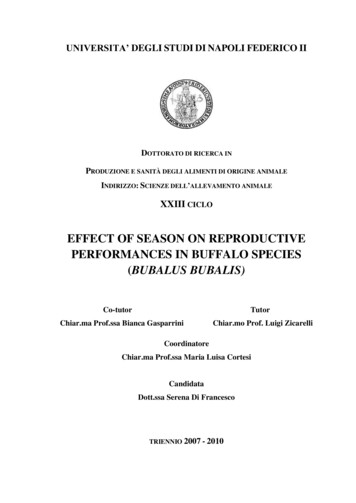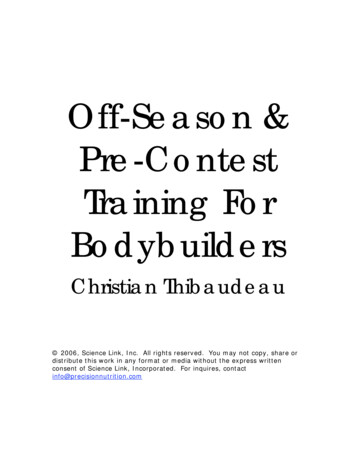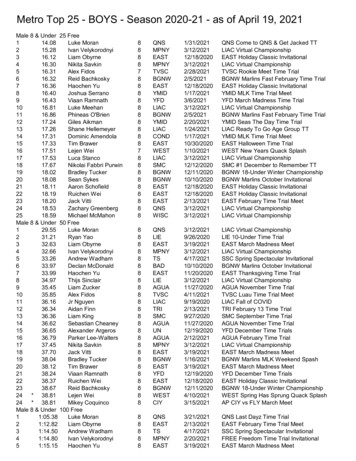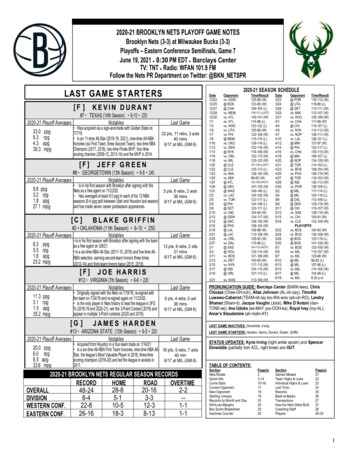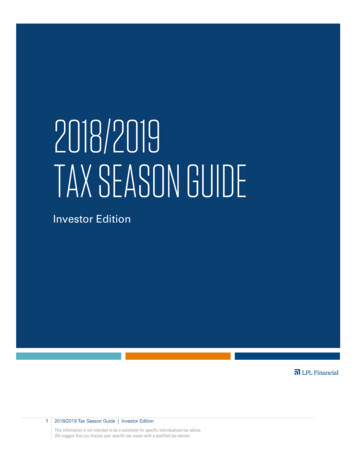
Transcription
2018/2019TAX SEASON GUIDEInvestor Edition12018/2019 Tax Season Guide Investor EditionThis information is not intended to be a substitute for specific individualized tax advice.We suggest that you discuss your specific tax issues with a qualified tax advisor.
INTRODUCTIONTo ease some of the burdens of tax season we’ve created this helpful guide, whichcontains all the information you may need to easily address tax issues andquestions that you might face. It will assist you in becoming familiar withimportant dates, deadlines, challenges, and opportunities that may arise during taxseason.Of course, if you have additional questions about anything included in this guide,we’re just a phone call away. We look forward to working with you this taxseason!22018/2019 Tax Season Guide Investor EditionThis information is not intended to be a substitute for specific individualized tax advice.We suggest that you discuss your specific tax issues with a qualified tax advisor.
CONTENTSGetting Started4457Preliminary Tax StatementAccess AccountView to View Your Tax FormsYear-End Checklist2019 Mailing ScheduleYear-end Planning910101112Roth ConversionUsing Premier Check Writing DistributionsWhat are the Required Minimum Distribution (RMD) Service Deadlines?Changes to Federal and State Voluntary WithholdingYear-end GiftingTax Season Essentials131314Important Dates and DeadlinesTax Form Mailing ScheduleReclassification, Corrections, and Filing ExtensionsFrequently Asked Questions1718Preliminary Tax StatementsTax SeasonAppendix203Helpful Information and Tables2018/2019 Tax Season Guide Investor EditionThis information is not intended to be a substitute for specific individualized tax advice.We suggest that you discuss your specific tax issues with a qualified tax advisor.
GETTING STARTEDPreliminary Tax StatementPreliminary Tax Statements will allow you to receive an advanced preliminary DRAFT copy ofyour 1099-Consolidated tax forms that will be available in AccountView on February 19. Thisis only for accounts not receiving the original 1099-Consolidated tax statement on January 31or February 15. For this population of accounts, you will receive your original final tax formseither on March 1 or March 15. A preliminary 1099 Consolidated Tax Form Statement is anadvanced DRAFT copy of your 1099 tax forms. The draft form should NOT be considered finaland should NOT be used for the purpose of filing tax returns with the IRS or with any state orother regulatory authority. All pages of the document are for your information only and mayassist you with tax preparation. A preliminary 1099 Consolidated Tax form statement will beavailable in AccountView, or through your Financial Advisor on February 19 for accounts thatwill not receive a final 1099 Consolidated Tax Statement until March 1 or March 15. Thepreliminary statements will NOT be mailed or viewable on TurboTax.The preliminary form will be watermarked with the message “Preliminary- DO not use for taxreturn.” You should submit the FINAL documents to the IRS.IMPORTANT: Preliminary tax statements are ONLY for 1099-Consolidated.LPL will not be responsible for reimbursement of re-filing fees or any other fees associatedwith the preparation and filing of an amended tax return.Access AccountView to View Your Tax FormsHow can I access my AccountView Profile to view my tax statements?Providing you with AccountView is one way we are committed to help you pursue yourfinancial goals. Accessed from your computer, tablet or smartphone, AccountView providessecure, convenient, 24-hour online access to your investment account information.Here are a few things to keep in mind:4 You will need to have your email open in order to retrieve a verification message thatwill be sent from noreply.myaccountviewonline@lpl.com. Addingnoreply.myaccountviewonline@lpl.com to your contacts or address book will ensurereceipt of the verification message. Have one of your LPL Financial account numbers on hand as it will be required tovalidate your identity.2018/2019 Tax Season Guide Investor EditionThis information is not intended to be a substitute for specific individualized tax advice.We suggest that you discuss your specific tax issues with a qualified tax advisor.
Follow these steps:1. Access AccountView through my website or directly at:https://myaccountviewonline.com/AccountView/2. Create an account by clicking Sign Up for AccountView.3. Enter the last 4 digits of your Social Security Number or Tax ID Number, one of your LPLFinancial Account Numbers and your Zip or Postal Code. The zip code and SSN you enterhave to match what is on the account. Once you have entered your information,click Continue.4. Create a User Name by typing a name into the User Name field. Click on Test Availability tocheck if your desired User Name is available. If not, select a new User Name.5. Please reach out to me if you have any questions regarding setting up yourAccount View Profile.Year-End ChecklistTo prepare for tax season, here are a few things you will need to keep in mind.Should any of these circumstances apply to you, please notify your advisor todiscuss your account. Federal and State Voluntary Withholding – If you have had a change of addressin 2018, you must notify your advisor by December 14, 2018 to ensure thatwithholding amounts can be corrected within the same tax year. It’srecommended that you review your account transactions regularly with youradvisor to verify that withholdings on distributions have been properly applied.LPL is not able to reverse or apply any federal and state withholding in 2019on distributions that occurred in 2018 for Individual Retirement Account (IRA)and Qualified Retirement Plan (QRP) accounts. Federal and statewithholdings will be reported in boxes 4 and 12, respectively, on IRS Form1099-R, and these tax payments may be claimed as dollar-for- dollar creditson your tax returns. 5Required Minimum Distribution – You are required by the Internal RevenueService (IRS) to take a required minimum distribution (RMD) by April 1 of the yearfollowing the calendar year in which you reach age 70½ and each year thereafterfrom your retirement accounts. The first year following the year you reach age70½ you will generally have two required distribution dates: an April 1 withdrawal(for the year you turn 70½), and an additional withdrawal by year end (for the yearfollowing the year you turn 70½). To avoid having both of these amounts includedin your income for the same year, you can make your first withdrawal by year endof the year you turn 70½ instead of waiting until April 1 of the following year. Ifyou’re already meeting your RMD requirements elsewhere and therefore do notneed to take a distribution from LPL, the IRS still requires that LPL furnish this2018/2019 Tax Season Guide Investor EditionThis information is not intended to be a substitute for specific individualized tax advice.We suggest that you discuss your specific tax issues with a qualified tax advisor.
information. If you need to take an RMD, please contact your financial advisor tohelp you request this distribution.RMDs generally are determined by dividing the prior year-end IRA balance by thelife expectancy factor (or distribution period), as defined in IRS tables. RMDsduring your lifetime are based on a distribution period that can be determinedusing the Uniform Lifetime Table and your age. The distribution period is notaffected by your beneficiary's age unless your sole beneficiary (for the entire year)is your spouse who is more than 10 years younger than you. If these assumptionsare not accurate, please contact your financial advisor for a new RMD calculation.Please note: If your IRA is holding assets in which the values are not readilyascertainable on an established exchange or generally recognized market, yourability to rely upon the year-end account balance as a basis for computing therequired minimum distribution relating to your IRA will depend upon such balancereflecting the fair market value of such assets. Please review the value shown forany such asset on your year-end account statement and provide any othervaluation information you may have for such asset to your financial advisor so thata new RMD calculation can be made. [Please note that neither LPL Financial northe Custodian of your IRA is responsible for any loss resulting from the valuationof any such asset.] Gifting – Charitable giving is one way you can positively impact your currenttax position, and satisfy RMD requirements with proper distributionpaperwork. You may gift shares from an LPL account to a third party as acharitable donation. To facilitate a year-end gifting request, please contactyour advisor. LPL must receive signed instructions from you no later thanDecember 14, 2018 to ensure that the gifting of shares takes place andsettles in the desired account by year-end. Any requests received afterDecember 14, 2018, will be processed on a best-efforts basis.*Shares may be gifted from an LPL Financial non-retirement accountto a third party (shares held directly with transfer agent) using theAccommodation Transfer form (F30). F30 must be received byNovember 9, 2018. Roth Conversions – You may want to contact your advisor before the end ofthe year to discuss the details of converting your existing IRAs to a Roth IRA.You’re likely aware of the benefits of Roth IRAs: tax-free withdrawals inretirement, no RMDs, and the option to leave an income-tax–free legacy tothe next generation. To process requests by December 31, 2018, we mustreceive completed request forms by December 14, 2018.Any requests received after December 14, 2018 will be processed on abest-efforts basis.Please be aware that LPL is only responsible for reporting during the timeyour assets were held at LPL. If you transferred your assets into LPL youshould check with you previous Broker Dealer for necessary Tax forms.* Traditional IRA account owners should consider the tax ramifications, ageand income restrictions in regards to executing a conversion from aTraditional IRA to a Roth IRA. The converted amount is generally subject toincome taxation. Effective January 1, 2018, pursuant to the Tax Cuts and62018/2019 Tax Season Guide Investor EditionThis information is not intended to be a substitute for specific individualized tax advice.We suggest that you discuss your specific tax issues with a qualified tax advisor.
Jobs Act (Pub. L. No. 115-97), a conversion from a traditional IRA, SEP orSIMPLE to a Roth IRA cannot be recharacterized. The new law also prohibitsrecharacterizing amounts rolled over to a Roth IRA from other retirementplans, such as 401(k) or 403(b) plans. Cost Basis – Your cost basis must be adjusted for certain events such as:corporate action, wash sale, return of capital, liquidation distribution, OIDaccrual, partnership distribution, undistributed capital gain, bond premiumamortization, market discount accrual, dividends effective for prior year (i.e.mutual funds), etc.Also, if you have any securities transferring from another firm, please be sureto have the cost basis transferred before December 14, 2018. Pleasecontact your financial advisor if you have any questions.Finally, please keep in mind that any fixed income elections for 2018 must bemade by close of business on December 31, 2018. This may affect taxreporting for fixed income on the 1099-INT. Please contact your financialadvisor if you have any questions. 2019 Requests – To ensure we’re processing your distribution requestscorrectly, it’s important that you wait to submit your 2019 distributionrequests until the new year. Any requests processed in 2018 will be appliedto 2018 tax reporting, so waiting to submit your 2019 request until the newyear will ensure that we apply reporting of your transactions in the correctyear and avoid sending multiple (and corrected) tax forms to you and the IRS.2019 Mailing ScheduleMail DateIRS Tax FormJanuary 31(Accounts not subject toreclassification)1099Consolidated 1099-DIV 1099-INT 1099-B 1099-MISC 1099-OIDFebruary 15March 1(Accounts subject February 19(Preliminary 1099 ConsolidatedTax Statement – Draft Copy.Includes accounts that will notreceive a final 1099Consolidated Tax Statementuntil March 1 or March 15.)March 15(Accounts subject toReclassification,OID/REMICs, &WHFITs)(Revised 1099s IssuedApril through October 2019)72018/2019 Tax Season Guide Investor EditionThis information is not intended to be a substitute for specific individualized tax advice.We suggest that you discuss your specific tax issues with a qualified tax advisor.PurposeReports payments clients receiveas taxable dividend income, capitalgain distributions from mutualfunds, gross income attributable toWHFITs, federally tax-exemptinterest, original issue discount(OID) on debt obligations, royaltypayments, sale of securities (andtheir cost basis and holding period),and merger considerations.Notes on reclassification: If youraccount held a RIC, REIT, UIT,foreign security, or municipal bondfunds, these may be subject toincome reclassification and will beissued later in February or Marchand could result in 1099 revisions.
January 31(Revised 1099-Rs IssuedFebruary through July2019)1099-RIRA / QRPReports distributions clients receivefrom IRAs and QRPs. Includesdirect rollovers from a QRP to anIRA and trustee-to-trustee transfersof recharacterized contributions.January 311099-QCOVERDELLESAReports distributions your clientreceived from qualified educationprograms under sections 529and 530.January 31(Beneficiaries Only)5498IRAThe fair market value (FMV) of youraccount is reported on yourDecember 2018 monthlystatement. This 5498 is provided tobeneficiaries who may not be therecipient of the year-end statement.March 151042-SNon-ResidentAlien/ForeignAccountsReports dividend and interestincome distributed, and associatedwithholding to non-resident alien(NRA) or foreign accounts.March 292439Non-RetirementReports client’s portion ofundistributed long-term capitalgains retained by mutual funds,which you can claim as a credit onyour tax return.April 15990-TIRAReports unrelated business taxableincome (UBTI) earned in an IRA onan alternative investment such as alimited partnership.May 15498-ESACoverdell ESAReports contributions made to aCoverdell education savingsaccount (ESA) to pay qualifiededucation expenses.May 315498-IRAIRAReports contributions made to atraditional or Roth IRA for the 2018tax year from January 1, 2018,through April 15, 2019. Includesreceipt of direct rollovers andrecharacterized contributions.SEP and SIMPLE employercontributions are reported in thecalendar year made, not applied.FOR INFORMATIONAL PURPOSESONLY. These documents are notrequired to be filed with your taxreturn.82018/2019 Tax Season Guide Investor EditionThis information is not intended to be a substitute for specific individualized tax advice.We suggest that you discuss your specific tax issues with a qualified tax advisor.
YEAR-END PLANNINGRoth ConversionsWhat are the benefits of moving from a traditional IRA to a Roth IRA?Benefits of Roth IRAs include: tax-free withdrawals in retirement (as long as they arequalified), no required minimum distributions, and the option to leave an income-tax–free legacy to the next generation. When considering a Roth IRA conversion, it is nota “one size fits all” approach as a variety of factors will need to be considered anddiscussed with your tax professional.*After we discuss your options with your tax professional, if you decide to convertassets from a traditional, SEP, SAR-SEP or SIMPLE IRA (only available after twoyears since the first contribution) into a Roth IRA (only available after two years sincethe first contribution) then we will need to complete the appropriate request form.The year-end deadline for 2018 to submit Roth Conversions for guaranteedprocessing is December 14, 2018. Roth conversions requested after this date willbe processed on a best efforts basis due to the increased volume during this period.Please note: Beginning in 2016, clients can make only one rollover from an IRA toanother (or the same) IRA in any 12-month period, regardless of the number ofIRAs they own.The one-per year limit does not apply to: rollovers from traditional IRAs to Roth IRAs (conversions)trustee-to-trustee transfers to another IRAIRA-to-plan rolloversplan-to-IRA rolloversplan-to-plan rollovers*Traditional IRA account owners should consider the tax ramifications, age andincome restrictions in regards to executing a conversion from a Traditional IRA to aRoth IRA. Required Minimum Distributions (RMDs) may not be converted to a RothIRA. The converted amount is generally subject to income taxation. The Roth IRAoffers tax deferral on any earnings in the account. Withdrawals from the accountmay be tax free, as long as they are considered qualified. Limitations and restrictionsmay apply. Withdrawals prior to age 59.5 or prior to the account being opened for 5years, may result in a 10% IRS penalty tax. Future tax laws can change at any timeand may impact the benefits of Roth IRAs. Their tax treatment may change.Effective January 1, 2018, pursuant to the Tax Cuts and Jobs Act (Pub. L. No. 11597), a conversion from a traditional IRA, SEP or SIMPLE to a Roth IRA cannot berecharacterized. The new law also prohibits recharacterizing amounts rolled over to aRoth IRA from other retirement plans, such as 401(k) or 403(b) plans.92018/2019 Tax Season Guide Investor EditionThis information is not intended to be a substitute for specific individualized tax advice.We suggest that you discuss your specific tax issues with a qualified tax advisor.
For more information on Roth conversions please visit (https://www.irs.gov/pub/irspdf/p4530.pdf).Using Premier Check Writing DistributionsIf you are planning on using Premier Check Writing for a 2018 distribution, please beaware that the distribution is reported for the tax year that the check is cashed (notthe year that check is written). It is strongly recommended that you avoid usingPremier Check Writing checks on retirement accounts near year-end if the check isintended to be reported in tax year 2018 because we do not have control over whenthe check will be cashed. Distributions are reported in the year the funds leave theaccount; therefore, checks cashed in 2019 will be reported as a 2019 distribution. AllPremier Check writing distributions are processed without any federal or statewithholding. You should speak to your tax advisor prior to processing a distributionwithout withholding as under-withholding penalties may apply to those that choosenot to withhold taxes.Other methods you can use to request distributions near year end are: ACHWire transferManual check created and mailed by LPLWhat are the Required Minimum Distribution (RMD) ServiceDeadlines?New Requests for 2018 ProcessingIf you are 70½ years of age or older, or you have Beneficiary accounts subject toRMD, you can establish a distribution schedule for the RMD that recalculates eachyear. Once the service is established, you will no longer need to manage the RMDprocess. During the first year that you subscribe to the RMD Service, distributionsof the calculated RMD amount will be divided to fit the time remaining in the year.For example, if you choose a monthly frequency with distributions to begin inOctober, the RMD amount for the year will be divided into three equal monthlyinstallments. Each following year, the RMD Service will automatically calculate yourRMD and withdraw it on a monthly basis.If you would like to establish RMD Service for 2018, the request should be receivedno later than December 1, 2018 as RMD’s cycle on the 10th and the 25th of eachmonth. If you fail to withdraw a RMD, fail to withdraw the full amount of the RMD,or fail to withdraw the RMD by the applicable deadline, the amount not withdrawn istaxed at 50%. LPL is not
reporting for fixed income on the 1099-INT. Please contact your financial advisor if you have any questions. 2019 Requests – To ensure we’re processing your distribution requests correctly, it’s i
